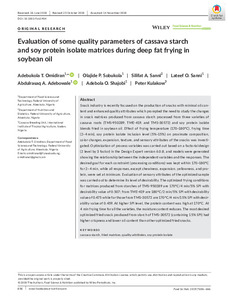| dc.contributor.author | Omidiran, A.T. |
| dc.contributor.author | Sobukola, O.P. |
| dc.contributor.author | Sanni, S.A. |
| dc.contributor.author | Sanni, L.O. |
| dc.contributor.author | Adebowale, A.A. |
| dc.contributor.author | Shajobi, A.O. |
| dc.contributor.author | Kulakow, P. |
| dc.date.accessioned | 2022-09-14T12:02:48Z |
| dc.date.available | 2022-09-14T12:02:48Z |
| dc.date.issued | 2019-02 |
| dc.identifier.citation | Omidiran, A.T., Sobukola, O.P., Sanni, S.A., Sanni, L.O., Adebowale, A.A., Shajobi, A.O. & Kulakow, P. (2019). Evaluation of some quality parameters of cassava starch and soy protein isolate matrices during deep fat frying in soybean oil. Food Science & Nutrition, 7(2), 656-666. |
| dc.identifier.issn | 2048-7177 |
| dc.identifier.uri | https://hdl.handle.net/20.500.12478/7749 |
| dc.description.abstract | Snack industry is recently focused on the production of snacks with minimal oil content and enhanced quality attributes which prompted the need to study the changes in snack matrices produced from cassava starch processed from three varieties of cassava roots (TMS‐950289, TME‐419, and TMS‐30572) and soy protein isolate blends fried in soybean oil. Effect of frying temperature (170–180°C), frying time (2–4 min), soy protein isolate inclusion level (5%–15%) on proximate composition, color changes, expansion, texture, and sensory attributes of the snacks was investigated. Optimization of process variables was carried out based on a factorial design (2 level by 3 factor) in the Design Expert version 6.0.8, and models were generated showing the relationship between the independent variables and the responses. The desired goal for each constraint (processing conditions) was kept within 170–180°C for 2–4 min, while all responses, except chewiness, expansion, yellowness, and protein, were set at minimum. Evaluation of sensory attributes of the optimized sample was carried out to determine its level of desirability. The optimized frying conditions for matrices produced from starches of TMS‐950289 are 170°C/4 min/5% SPI with desirability value of 0.507; from TME‐419 are 180°C/2 min/5% SPI with desirability value of 0.475 while for those from TMS‐30572 are 170°C/4 min/15% SPI with desirability value of 0.459. At higher SPI level, the protein content was high at 170°C. At 4 min frying time for all the varieties, the moisture content reduces. The most desired optimized fried snack produced from starch of TMS‐30572 (containing 15% SPI) had higher crispness and lower oil content than other optimized fried snacks. |
| dc.format.extent | 656-666 |
| dc.language.iso | en |
| dc.subject | Cassava Starch |
| dc.subject | Cassava |
| dc.subject | Quality |
| dc.subject | Soybeans |
| dc.subject | Proteins |
| dc.subject | Nigeria |
| dc.title | Evaluation of some quality parameters of cassava starch and soy protein isolate matrices during deep fat frying in soybean oil |
| dc.type | Journal Article |
| cg.contributor.crp | Roots, Tubers and Bananas |
| cg.contributor.affiliation | Federal University of Agriculture, Abeokuta |
| cg.contributor.affiliation | International Institute of Tropical Agriculture |
| cg.coverage.region | Africa |
| cg.coverage.region | West Africa |
| cg.coverage.country | Nigeria |
| cg.coverage.hub | Headquarters and Western Africa Hub |
| cg.researchtheme | Biotech and Plant Breeding |
| cg.identifier.bibtexciteid | OMIDIRAN:2019 |
| cg.isijournal | ISI Journal |
| cg.authorship.types | CGIAR and developing country institute |
| cg.iitasubject | Agronomy |
| cg.iitasubject | Cassava |
| cg.iitasubject | Crop Systems |
| cg.iitasubject | Food Security |
| cg.journal | Food Science & Nutrition |
| cg.notes | An Open Access Article; Published online: 19 Dec 2018 |
| cg.accessibilitystatus | Open Access |
| cg.reviewstatus | Peer Review |
| cg.usagerightslicense | Creative Commons Attribution 4.0 (CC BY 0.0) |
| cg.targetaudience | Scientists |
| cg.identifier.doi | https://dx.doi.org/10.1002/fsn3.904 |
| cg.iitaauthor.identifier | Peter Kulakow: 0000-0002-7574-2645 |
| cg.futureupdate.required | No |
| cg.identifier.issue | 2 |
| cg.identifier.volume | 7 |

